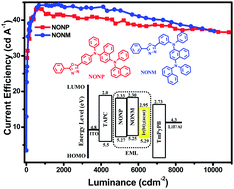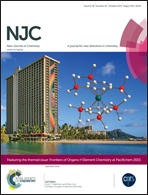Highly efficient yellow phosphorescent OLEDs based on two novel bipolar host materials†
Abstract
Two bipolar host materials, N1-(naphthalen-1-yl)-N1,N4-diphenyl-N4-(4-(5-phenyl-1,3,4-oxadiazol-2-yl)phenyl)naphthalene-1,4-diamine (NONP) and N1-(naphthalen-1-yl)-N1,N4-diphenyl-N4-(3-(5-phenyl-1,3,4-oxadiazol-2-yl)phenyl)naphthalene-1,4-diamine (NONM), comprising a hole-transporting N1-(naphthalen-1-yl)-N1,N4-diphenylnaphthalene-1,4-diamine (NPNA2) donor and an electron-transporting 1,3,4-oxadiazole (OXD) acceptor at different phenyl bridge positions, have been synthesized. NONP (glass transition temperature Tg = 127 °C) and NONM (Tg = 105 °C) exhibit high morphological stability. The theoretical calculations on both hosts show that the HOMOs (highest occupied molecular orbitals) are mainly dispersed on the electron-donating groups, and the LUMOs (lowest unoccupied molecular orbitals) are predominantly dispersed on the electron-accepting units, suggesting bipolar charge transporting property. Two yellow phosphorescent organic light-emitting diodes (PHOLEDs, ITO (indium tin oxide)/TAPC (1,1-bis[4-(di-p-tolylamino) phenyl]cyclohexane, 40 nm)/host: Ir(bt)2(acac) (bis(2-phenylbenzothiozolato-N,C2′) iridium(acetylacetonate), 15 wt%, 20 nm)/TmPyPB (1,3,5-tri(m-pyrid-3-yl-phenyl) benzene, 40 nm)/LiF (1 nm)/Al (100 nm)) fabricated using NONP and NONM as the host and Ir(bt)2(acac) as the emitter exhibit maximum current efficiencies (ηc,max) of 43.2 and 44.4 cd A−1, respectively, with low current efficiency roll-off. The values of 40.4 and 43.6 cd A−1 can still be achieved at the luminance of 3000 cd m−2, respectively.


 Please wait while we load your content...
Please wait while we load your content...